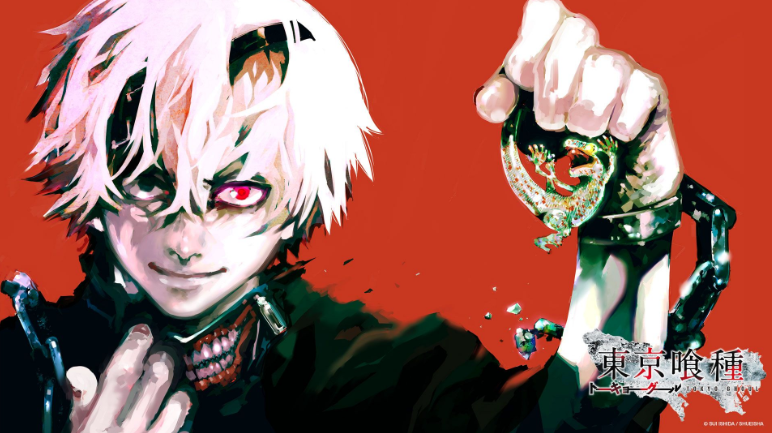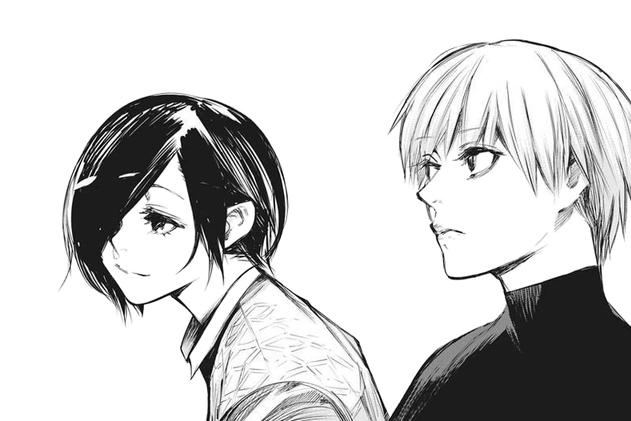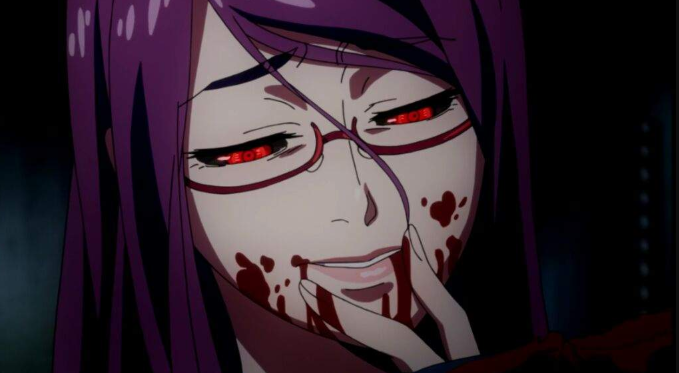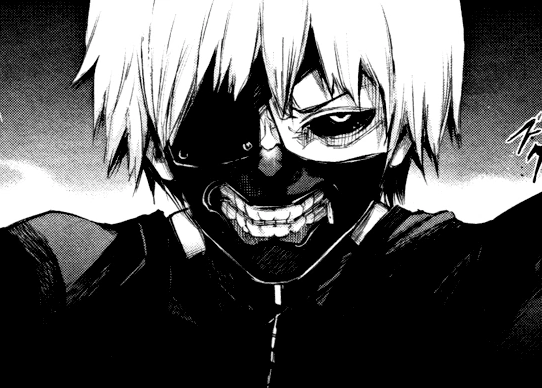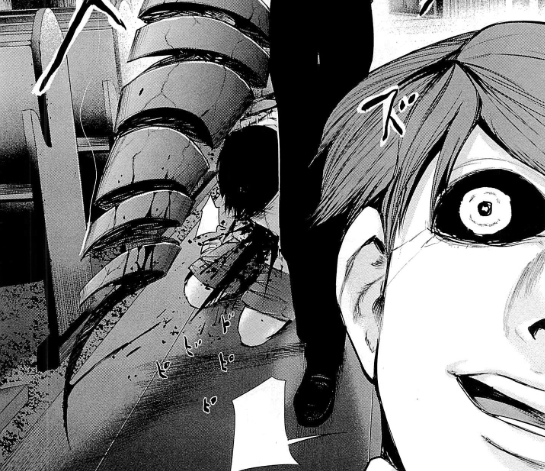Thoughts on... Tokyo Ghoul: Manga Review (Part 1, very minor spoilers)
I am embarrassingly late to Tokyo Ghoul for several reasons. Years ago, I took a break from dark fantasy media after the deluge of Twilight reincarnations that dominated the YA shelves in every Waterstones in England. I had also started—and dropped—Vampire Knight after the narrative took an uncomfortable turn. I remember Tokyo Ghoul had a lot of hype surrounding it, but when I read the premise I felt fatigued by the whole affair and gave it a pass. Secondly, there was an insane scandal following the conclusion of the series’ Part Two, :Re, that escalated in the creator, Sui Ishida, receiving death threats on Twitter. I witnessed the rabid so-called fans harassing this guy for ending the series in a particular way. I guess it had something to do with a romance or some equally trivial issue, but either way everyone lost their minds and it put me off the series and the fandom. I just didn’t have time for a shipping war.
This month, however, I decided to give it a go. In the long, long wait between Berserk chapters, fans of the series have taken to recommending other equally tragic and compelling dark fantasy shonen/seinen titles on Reddit and other forums, and besides the obvious Kingdom, Vinland Saga and Vagabond suggestions, Tokyo Ghoul keeps cropping up in discussions. It made me reconsider the manga. I can say immediately that the two series are nothing alike, and any similarities are tenuous and so close to the surface that they can pretty much be compared to any series of the same genre: male outcast protagonist thrown into a new world, battling against government corruption, flesh-eating monsters, picking up a special power along the way that distinguishes him from everyone else. Include some trauma, heartache, and some gore, and you have the basic premise of many other manga. This doesn’t mean that Tokyo Ghoul is generic or boring, in my opinion Ishida takes all these tropes and does a damn good job with them, whilst still putting his own unique mark on the dark fantasy genre. I very much enjoyed this manga.
Kaneki and Touka. We love them!
The entire series is available on the Shonen Jump app, but at the moment, the second part, :Re, has not been fully uploaded, so for now, I’ll just cover Part One of Tokyo Ghoul in this review and do the sequel at a later date.
The world of Tokyo Ghoul is fractured by the existence of ghouls: violent, super-strong creatures that look exactly like humans. They assimilate into human society as best they can, but their only source of food is human flesh because normal food repulses them. As one would expect, humans are fearful of ghouls, and many ghouls mercilessly kill and eat humans. To combat the ghoul crisis, an organisation was founded by the impressive and mysterious Washuu Clan to eliminate ghouls from society. Over a century later, and the government-backed CCG (Commission of Counter-Ghoul) is formed, made up of ghoul investigators each armed with quinques: these are weapons infused with ghoul-like powers, which they use to protect human society from its natural enemy.
Actually…let’s cancel.
The story follows Ken Kaneki, a loner bookworm who regularly visits a cafe to give hearteyes to another regular patron. The woman at the focus of Kaneki’s puppy love is Rize, who also reads novels by his favourite author, Ten Sakatsuki. Once this is realised by the pair, Rize agrees to go out on a date with him, but it turns out she’s a ghoul. She tries to eat him, but a large scaffolding pole is dislodged from a building above them, instantly killing Rize and leaving Kaneki unconscious with blood loss. Kaneki wakes up to find his damaged organs have been unethically replaced by Rize’s to save his life, to much media scandal and scrutiny. The subsequent backlash means nothing to him, because now, he is part ghoul, can no longer eat normal food, and constantly craves human flesh. This leaves him in constant turmoil as his mind is very much human, but his body is the opposite. He has to live in secret, away from his old life at university, avoiding his best friend Hide, and reluctantly integrates into ghoul society.
Kaneki’s internal conflict is palpable. Not only is he now severed from the human world, but he has no other human contact: both his parents are dead, and he suffered emotional abuse and neglect at the hands of his aunt, who nursed a deep jealousy of her deceased sister and her highly intelligent son. After living his entire life as a human and raised to fear ghouls like everyone else, he is totally disgusted with himself for craving human flesh, but without it, he grows weaker and his ghoul powers become erratic. I think it provides an interesting juxtaposition of the human Kaneki, who used to shy away from society within the pages of his many novels, and Kaneki the ghoul, forced into a nightmare underworld and craving humanness and human interaction. On the other hand, Kaneki was accustomed to feeling like an outcast as a child, and as the story progresses, he develops a deep sympathy for the ghouls who befriend him, and realises that they too suffer and live in fear of being hunted by humans over something they cannot control. As the man with one foot in both worlds, Kaneki becomes the potential solution to the cage of the manga’s world. This is a sentiment shared by Yoshimura, the father figure to many fugitive ghouls, and the owner of the cafe-cum-ghoul rehabilitation school, Anteiku.
Eyepatch! :)
I adore Kaneki as a protagonist. He is awkward but not annoyingly so, and his reactions to new situations, as well as his very open turmoil, is realistic as it is heartbreaking to witness. He undergoes several transformations during the manga, from the shy bookworm, to the conflicted ghoul dubbed Eyepatch by the CCG, to the respected and feared SS-class ghoul known as The Centipede, which is awakened after he is tortured by a ghoul from one of Anteiku’s enemy groups. Kaneki quickly makes a name for himself as his strength and skill develops thanks to the story’s potential love interest, Touka, a strong ghoul who is also an orphan overcoming her own traumatic past. Unfortunately, he becomes a feared and despised novelty for ghouls due to his obvious halfling status: when ghouls activate their powers, both their eyes turn black. In Kaneki’s case, only one of his eyes is activated, thus providing weight to the mysterious legend of the One Eyed King: a ghoul who is supposed to cause a great calamity or revolution that will permanently impact both the ghoul and human worlds.
Tokyo Ghoul is a multilayered story. It is more than just the tiresome “there are no enemies; both sides have merit” trope, but shows that life is far too complex to boil everything down to just two sides. Every individual ghoul and every human character has their own reasons for doing what they do, and they join various factions accordingly. Some investigators are sadistic towards ghouls because the CCG specifically recruits children who have lost their families to ghoul violence, and then trains them to channel that anger into investigative work as adults. Other investigators adhere to the morality codes of the CCG, not wanting to cause excessive harm to the ghouls they hunt, and maintaining a strong sense of justice for the innocent humans affected by ghoul lifestyles. Others use the organisation as a means to make a name for themselves, become a national hero, and waste a lot of their time engaging in personal conspiracies and conflicts with their colleagues.
Big Madame, a seriously fucked up individual.
Conversely, several ghouls in the story have no care for humans, and hunt them in the same way humans kill animals for food or sport. Then there are ghouls like the Anteiku members, who feed from humans that are already dead, choosing to procure their meat from suicide hotspots around the city. Several ghouls decide to join Aogiri Tree, a terrorist organisation that directly opposes the CCG. In addition, many smaller crews have their own part to play in the story, and the motives of all of these factions intertwine, leading to a major battle at the end of the manga where an old and powerful enemy, the One Eyed Owl, arises once more to wreak havoc with the CCG on the side of the ghouls.
Centipede! :(
The layers of the story is definitely one of its strengths, because honestly Ishida doesn’t preach any particular message other than “it’s complicated”. It is totally understandable why the CCG wants to hunt down ghouls, but it is also difficult not to sympathise with the ghoul population who, like the CCG child recruits, have equally lost parents and loved ones to senior CCG investigators. Pretty much everyone in this story has had a shitty life which has then affected their viewpoint on the world, and these experiences determine which group they choose to operate under.
I could compare Tokyo Ghoul with The Promised Neverland here, because both stories deal with non-human populations who require human flesh to survive. The demons of the latter are reduced to mindless bacteria without human flesh, however they have spent centuries sadistically farming unwitting children as “free range” produce, created a hunting amusement park in the form of Goldy Pond to satiate their lust for hunt and torture, and conspired with the corrupt Ratri family to eliminate any obstacles, both human and demon, to their general way of life and food.
Yeah… no.
I have already written about the issues with The Promised Neverland’s execution of the “two sides” story, so I won’t go into it too much here, but I do believe that the simplistic solution posed by Emma that “no one should die”, to the point of sympathising with the demons because “they’re just eating”, cheapens the set up of the Grace Field arc and the subsequent trauma that the children have endured at the hands of demons. Worse still, the lack of demon-world exploration means that the reader still has no reason to feel as heartbroken for the demons as much as Emma does, likewise many other characters did not see whatever she saw in the demon villages that changed her mind so drastically, but for some reason they all give her the benefit of the doubt and help her on her quest to keep the demons alive and live in harmony with them. The reaction of all the other characters confirms that the new direction of the manga is unrealistic, and unfortunately, this lack of in-human conflict has made the story fall flat.
Kaneki keeping ghouls in check by snapping sphenoid bones.
Tokyo Ghoul avoids these issues by clearly depicting the intra-demon and intra-human schisms. No one gets idealistically absolved of their past sins because there is always another character to counter their ideology. The problematic methods of all sides are thoroughly explored, and excuses are made for no one: yes, life is difficult for ghouls, but Kaneki’s answer to their predicament isn’t “it’s not their fault” but rather, “there should be another way”. Despite him knowing that human flesh is their only source of sustenance, he never hesitates to challenge or kill any ghoul who threatens the lives of innocent humans. Anteiku’s feeding habits provide a solution which directly challenges the more recreational and sadistic behaviours of other ghouls. Kaneki regularly has to team up with the infamous Shuu Tsukiyama, also known as the Gourmet: a ghoul who hosts a gladiator-style meat auction and who also happens to be obsessed with Kaneki’s apparent alluring flavour. Kaneki never hides his disdain for Shuu and regularly makes it clear that their allyship is strictly professional and necessary in the wider scheme of the city’s conflict. He keeps a watchful eye on Shuu, always mindful of the ghoul’s distasteful habits.
He forms a similar partnership with Nishiki Nishio, a ghoul who tries to eat Hide early on in the story, but who also has his own precarious situation via his relationship with a human who desperately tries to feed and protect him at the risk of her own life. Nishio and Shuu are made to prove themselves to Kaneki time and time again, and they undergo their own rehabilitation by either joining, or aligning with, Anteiku. Kaneki’s realist approach to the difficult world he navigates, whilst battling with his self-disgust at craving human meat, prevents him for attempting cookie-cutter solutions to a conflict that will have permanent repercussions for everyone involved, a conflict that has already destroyed lives and left scars that cannot be so easily healed with idealist stubbornness, which is Emma’s signature, consequence-free trait that dominates the narrative of Neverland.
There is another aspect of the story that is worth mentioning here. Of course, Tokyo Ghoul becomes much more than a ghoul-hunting story, and as new characters and factions are introduced, the mystery of Rize, the doctor who performed Kaneki’s procedure, and the other players that are subtly pulling a series of intricately woven strings are teased in such an artful way. The tension constantly mounts in the background of this story, and by the time we reach the closing chapters, our opinions of certain characters change completely, and we no longer trust any one group over the other. All the ingredients for a massive conspiracy are there in the bowl, and as the reader, you both dread and hotly anticipate the moment when all these elements come together.
Shuu the madlad.
Despite my high praise, I have a few criticisms. Firstly, Ishida has a habit of discarding plot points only to awkwardly explain them much later, when they should have been formed properly from the offset. For example, early on in the story, Kaneki’s entire university life completely disappears from the narrative as he assumes his new clandestine existence. Considering that Hide is his childhood friend who always hung out with him, I thought it odd that we didn’t see Hide on his own side-mission to find out where Kaneki vanished off to. Likewise, it is not explained how Kaneki is able to just drop his former human life and exist as a ghoul without his lecturers and classmates asking important questions. Halfway through the manga, it is revealed that Kaneki has been classed as a missing person, and his poster is all over the university. Additionally, Hide joins the CCG and admits that his best friend—whom he knows is a ghoul because he overheard Yoshimura discussing the fact at Anteiku’s cafe—is the wanted Eyepatch ghoul. Considering that Hide and Kaneki are supposed to be tight brothers, I thought this aspect of the latter’s life was poorly handled. Towards the end of the story, Hide appears again, but then he disappears the very next chapter, and the life-changing decision made between the pair is a thread that does not get picked up again way into the sequel series, so we are left wondering what happened to Hide for a long time.
Oh, so you were MISSING, were you?
The artwork of Tokyo Ghoul is beautiful. I’m often reminded of the amazing demonic designs found in Claymore when reading it. Every ghoul has their own way of fighting, so the manifestation of their powers can look arachnoid, hauntingly angelic, or down right grotesque. However, the complicated designs of the ghouls, coupled with the CCG’s quinques, can have an adverse affect on the fight panels. Sometimes it’s not clear what exactly is going on, who attacked whom, and who died, because there are just streaks of black limbs, white smoke, and overbearing sound affects cluttering the panels. Such artwork can stifle the reading a bit. This is exacerbated by inconsistent character designs, where in some instances, white-haired Kaneki starts to look like Hide; Touka looks almost identical to Ayato, and the flashback sequences of the investigator prodigy Arima look awfully similar to Kaneki at the start of the manga. On the plus side, the ghouls all wear unique masks designed by the quirky Uta to protect their identities from the CCG. These designs are stylish and vibrant and provide interesting monikers for our main ghouls: Kaneki is Eyepatch due to the black leather eyepatch incorporated into his mask, Touka is the Rabbit, and so-on. It brings an additional element of mystery and intrigue to the battles.
As a counter to my previous admiration for the wider conspiracy, I will say that at times, the mounting characters and motives become a little muddled during the final battle, and Ishida risks complicating the story too much in the same way that Isayama of Attack on Titan fame took far too long (in my opinion) to reel in the seemingly multiplying squadrons during the current War for Paradis arc. It was as if every month, another splinter group appeared and “revealed” their true motive. Likewise, Tokyo Ghoul suffers from a bloated cast of villains that are revealed too closely together to have much impact. It’s not a major criticism, but I did find myself having to keep a mental note of all the names, monikers, and the factions that these new characters belonged to.
There is a particular ghoul investigator that I really admire: the just and noble Amon. Due to an early encounter with Eyepatch, during which Kaneki begs Amon to run away because he doesn’t want to eat him, Amon quickly learns that there is more to ghouls than he first realised, and Eyepatch becomes his personal obsession, the one ghoul he seriously wants to meet and understand. This relationship had the makings of a Smoker and Luffy or Guts and Zodd narrative, where two members of opposing factions develop a precarious respect for each other, and find themselves having to team up at some point in the story for the “greater good”. This relationship amounts to nothing, and the aftermath of the abrupt divorce is… once again, not reclaimed until the latter half of the sequel.
I’m getting emotional. This could have been great.
This brings me to the biggest criticism I have of the series, and that’s the ending. I do take issue with authors who purposely leave their series on major cliffhangers. Even if there is a planned sequel, I’m of the view that every story should still have its own beginning, middle, and end, with a coherent conclusion that will not goad readers into getting the next instalment. In the case of Tokyo Ghoul, a majorly anticipated fight right at the denouement is purposely cut short, the conclusion unknown as the pages fade to black. Afterwards we are given a timeskip, stripped of the experience of witnessing the fallout of the battle, and instead treated to random character reflections of what took place several months ago. Kaneki re-emerges as a shock reveal at the end. I could all but hear the Eastenders-style “duff duff” noises in my head when I saw this page, and when I swiped left, the manga had finished. It was cheap to cut all the cords loose in this way, and I would have liked some more storytelling to at least give the characters a chance to come to terms with their new reality.
To conclude, I was pleasantly surprised with Tokyo Ghoul and I certainly regret waiting so long to read it. I guess that’s a lesson for me to never let the toxicity of a fandom stop me from discovering something great. I love Kaneki’s bookworm persona, and how his love of knowledge impacts the story. He overcomes obstacles with his human intellect and there are no ridiculous power ups without Kaneki learning from a book first. It makes him charmingly relatable. Now that I’m halfway through the sequel, I can see how far he has come as a character, and I appreciate his journey even more. This may be blasphemous to suggest, but I honestly think that if you are searching for a tragic and yet hopeful balm to the very dire depths that Berserk provides, Tokyo Ghoul is a definite remedy. It has a perfect balance of tragedy, comedy, and romance, without it delving into edginess. There many deaths, but these are not gratuitous or cheaply added in for forced deepness. Like Guts, Kaneki never stops struggling against the many unfair and unfortunate situations he is forced into. His story is compelling, and you truly want him to succeed in his own goals. I look forward to reading the conclusion to his story in the sequel, Tokyo Ghoul:re.
7/10
